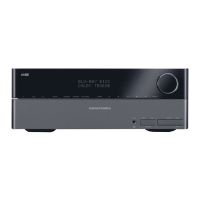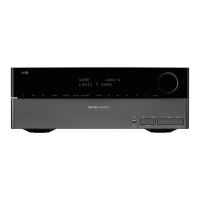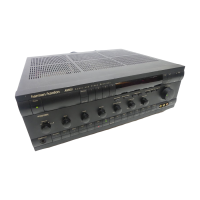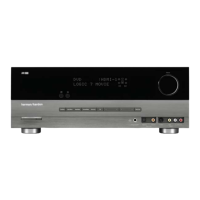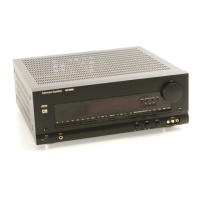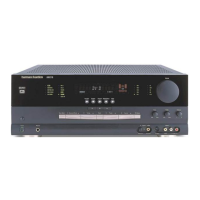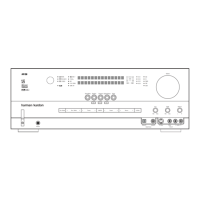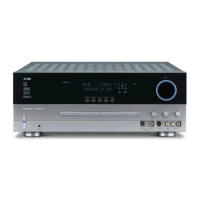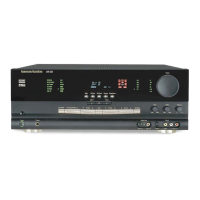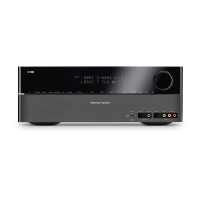INSTALLATION
If any source devices are equipped with a compatible Remote IR Input, use
a 1/8" (3,5 mm) mini-plug interconnect cable (not included) to connect the
AVR’s Remote IR Output to the source device’s Remote IR Input.
The AVR 460/AVR 360 outputs a “stripped carrier” IR signal through the
Remote IR Output, and the AVR 460 has a full-carrier IR signal available at the
Carrier Remote IR Output.
To control more than one source device through the Remote IR Output,
connect all sources in “daisy chain” fashion, connecting each device’s IR output
to the next device’s IR input, starting with the AVR. Connect devices expecting
a full-carrier IR signal to the AVR 460's Carrier Remote IR Output. Use the
Remote IR Output for devices expecting a stripped signal.
STEP EIGHT – Install a Multizone System
The AVR 460/AVR 360 offers several methods of distributing audio to other
areas in your home, and it also features video distribution.
IMPORTANT SAFETY NOTE
: Installing a multizone system typically
requires running cables inside walls. Always comply with the appropriate
safety codes when installing concealed wiring. Failure to do so may present
a safety hazard. If you have any doubt about your ability to work with
electrical and telecommunications wiring, hire a licensed electrician or
custom installer to install the multizone system.
When the system is installed using method B or C below, multizone operation
takes over the Surround Back/ Zone 2 amplifier channels, limiting the system
in the main listening room to 5.1 channels.
Select one or all of these methods for audio distribution:
Connect an external amplifier to the Zone 2 Audio A.
Outputs (AVR 460 only)
. It is recommended that you place the
amplifier in the same room as the AVR so that a shorter length of
interconnect cable is used with a long run of speaker wire to the remote
room. A long run of interconnect cable would be subject to signal
degradation. Depending on your amplifier, distribute the audio signal to a
single pair of speakers, or to several pairs placed in different rooms.
The Zone 2 Audio Outputs offer the benefit of 7.1-channel audio in the
main room simultaneously with multizone operation. However, the
benefit is achieved with the expense of an additional component, i.e., the
amplifier.
Connect the remote room’s speakers directly to the B.
Surround Back/Zone 2 Speaker Outputs
. Reassign the
Surround Back amplifier channels to power the speakers (see Advanced
Functions Manual).
Your main system will be limited to 5.1 channels, affecting playback of
programs recorded in 6.1 or 7.1 channels, which will be downmixed.
Connect an external amplifier to the Surround Back/Zone C.
2 Preamp Outputs
. This method requires an additional amplifier, but
may increase the total number of remote rooms when used with methods
A and B.
Connect an A-BUS hub or other A-BUS components to the D.
A-BUS port (AVR 460 only)
. Use Category 5/5e cable, as described
in the instructions for your A-BUS components. The A-BUS system carries
the audio signal to the remote components, while receiving IR control
codes. A hub may distribute audio to many remote rooms. To control
source devices exclusively from the remote A-BUS module, connect the
AVR’s Carrier Remote IR Output to a compatible IR input on the source.
This avoids having conflicting control commands sent to a source intended
for the A-BUS system.
IR commands received from the A-BUS system are also distributed to the
AVR’s other IR outputs. Visit the Web site at www.harmankardon.com for
information on available Harman Kardon hubs, the ABH 4 and ABH 4000,
and amplified in-wall modules, the AB 1 and AB 2.
Connect IR Control Devices to the Zone 2 IR Input
For methods A, B and C, connect an IR control device to the Zone 2 IR Input
for remote-room control of the multizone system, source devices and volume
in the remote zone. An A-BUS system does not require a separate IR control
connection.
NOTE
: Only analog audio sources are available to the multizone system.
For digital sources, make a second, analog audio connection. The Bridge III
source is available to the multizone system.
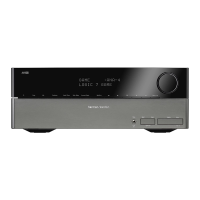
